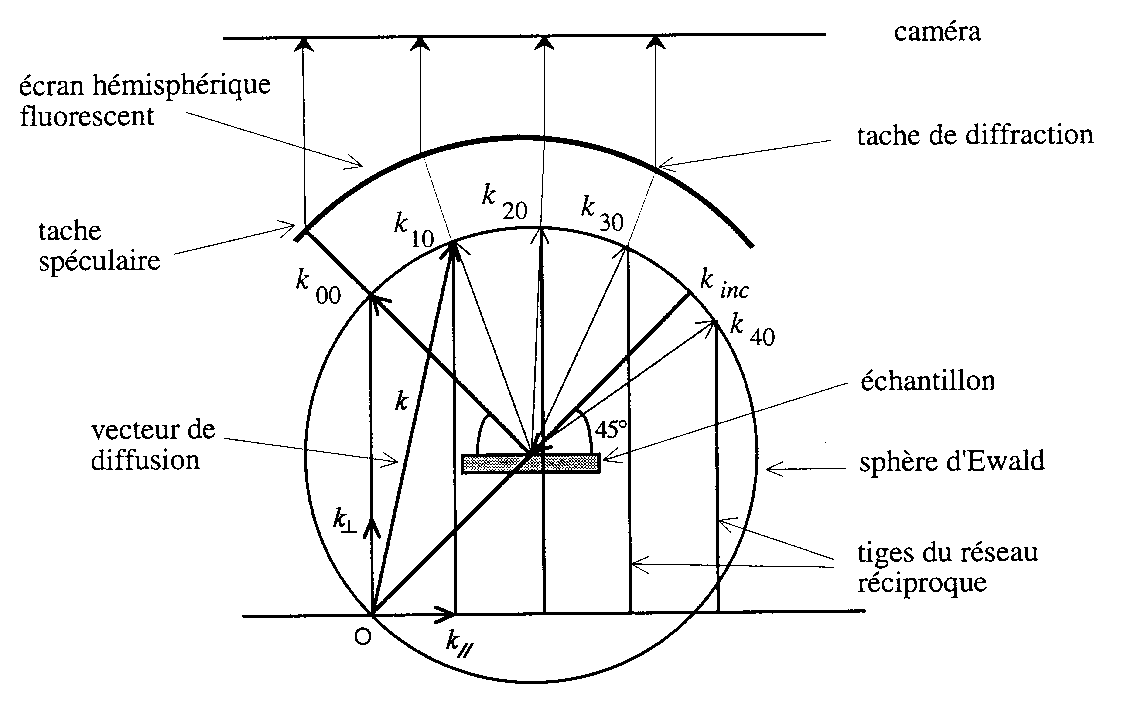

The further the rows are apart, then the closer in are the diffracted beams to the central (00) beam. For example, the rows of atoms running vertically on the screen would give rise to a set of diffracted beams in the horizontal plane, perpendicular to the rows, thus leading to the row of spots running in a line horizontally across the diffraction pattern through the (00) spot. In the case of such simple LEED patterns, it is possible to explain the diffraction pattern in terms of scattering from rows of atoms on the surface. This is what the real diffraction patterns might look like … it is representative of the diffraction pattern visible at low energies when only for n = 1 is the angle of diffraction, θ, sufficiently small for the diffracted beam to be incident on the display screen.īy contrast, the diagram below shows the diffraction pattern that might be expected if the energy of the incident electrons is doubled - some of the second order spots are now visible and the pattern as a whole has apparently contracted in towards the central (00) spot. The above illustration of the diffraction pattern shows only the "first-order" beams i.e. The pattern is also centrosymmetric about the (00) beam - this is the central spot in the diffraction pattern corresponding to the beam that is diffracted back exactly normal to the surface (i.e. The pattern shows the same rectangular symmetry as the substrate surface but is "stretched" in the opposite sense to the real space structure due to the reciprocal dependence upon the lattice parameter. The diffraction pattern on the right illustrates how these diffracted beams would impact upon the fluorescent screen. The primary electron beam would then be incident normally on this surface as if fired from your current viewpoint and the diffracted beams would be scattered from the surface back towards yourself. In the diagram below the surface atomic structure is shown on the left in plan view, as if you are viewing it from the position of the electron gun in the LEED experiment (albeit greatly magnified). The aforementioned points are in fact much more general - all surface diffraction patterns show a symmetry reflecting that of the surface structure, are centrally symmetric, and of a scale showing an inverse relationship to both the square root of the electron energy and the size of the surface unit cell.Īs an example we can look at the LEED pattern from an fcc(110) surface. sin θ is inversely proportional to the lattice parameter, a.sin θ is proportional to 1 / V 1/2 (since λ is proportional to 1 / V 1/2 ).the pattern is symmetric about θ = 0 (or sin θ = 0).There are a number of points worth noting from this simple 1-D model The diagram below shows a typical intensity profile for this case. The size of this path difference is a sin θ and this must be equal to an integral number of wavelengths for constructive interference to occur when the scattered beams eventually meet and interfere at the detector i.e.įor two isolated scattering centres the diffracted intensity varies slowly between zero (complete destructive interference d = ( n + ½) λ ) and its maximum value (complete constructive interference d = n λ ) - with a large periodic array of scatterers, however, the diffracted intensity is only significant when the "Bragg condition"

If you consider the backscattering of a wavefront from two adjacent atoms at a well-defined angle, \( θ\), to the surface normal then it is clear that there is a "path difference" ( d) in the distance the radiation has to travel from the scattering centres to a distant detector (which is effectively at infinity) - this path difference is best illustrated by considering two "ray paths" such as the right-hand pair of green traces in the above diagram. This is the simplest possible model for the scattering of electrons by the atoms in the topmost layer of a solid in which case the diagram below would be representing the solid in cross-section with the electron beam incident normal to the surface from the vacuum above. (Useful information: h = 6.62 x 10 -34 J s, e = 1.60 x 10 -19 C, m e = 9.11 x 10 -31 kg ).įrom the above examples the range of wavelengths of electrons employed in LEED experiments is seen to be comparable with atomic spacings, which is the necessary condition for diffraction effects associated with atomic structure to be observed.Ĭonsider, first, a one dimensional (1-D) chain of atoms (with atomic separation a ) with the electron beam incident at right angles to the chain. What is the wavelength of electrons of energy 200 eV ? What is the wavelength of electrons of energy 20 eV ? V - acceleration voltage ( = energy in eV ).


 0 kommentar(er)
0 kommentar(er)
